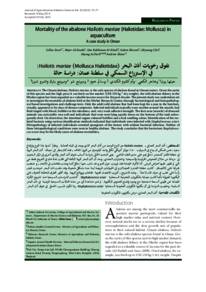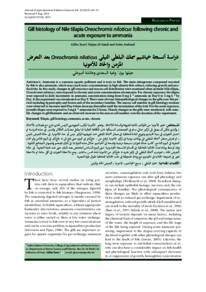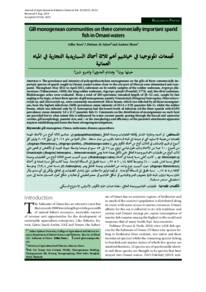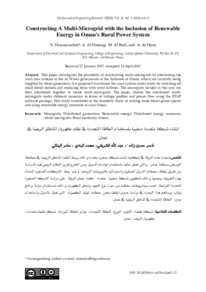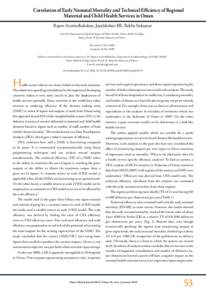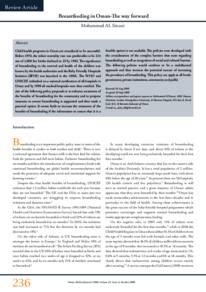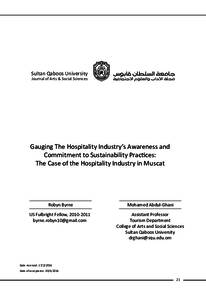Document
Mortality of the abalone Haliotis mariae (Haliotidae Mollusca) in aquaculture A case study in Oman.
Contributors
Al-Kaabiyah, Hajer., Author
Al-Kindiyah, Um Kalthoum., Author
Khoom, Salem., Author
Cho, Miyoung., Author
Publisher
جامعة السلطان قابوس. كلية العلوم الزراعية والبحرية
Gregorian
2015
Language
English
English abstract
The Omani abalone, Haliotis mariae, is the only species of abalone found in Omani waters. Given the rarity of this species and the high price it can fetch on the market (US$ 150 kg-1 dry weight), the wild abalone fishery in the Dhofar region has been regarded as a valuable income source for the past decade. The present study was undertaken set to investigate the mortality of abalone held at the Mirbat Research Center, through bacteriological and histopathological based investigations and challenge tests. Only the adult wild abalone that had been kept for a year in the hatchery, visually, appeared to be clear of disease symptoms. Infected individuals typically were swollen around the mouth, had fluid tinged with blood, bubbles in the intestines, and, very weak adhesive strength. The foot area (muscle) of diseased animals was noticeably very soft and individuals that were seen lying upside down on the bottom of the tank subsequently died. On dissection, the intestinal organs released bubbles and a foul smelling odour. Identification of the isolated bacteria using various identification methods indicated that individuals were infected with Staphylococcus sciuri. Histopathology of infected individuals revealed spongiosis of the tissues with evident bacterial infection. Neither of these histopathological conditions were seen in healthy abalone. The study concludes that the bacterium Staphylococcus sciuri may be the likely cause of abalone mortalities,.
Member of
ISSN
2410-1079
Resource URL
Citation
Yoon, G., Al-Kaabiyah, H., Al-Kindiyah, U., Khoom, S., Cho, M., Park, M. A., & Shinn, A. (2015). Mortality of the abalone Haliotis mariae (Haliotidae: Mollusca) in aquaculture A case study in Oman. Agricultural and Marian Sciences Journal, 20 (1), 73-77.
Arabic abstract
أذن البحر العماني Haliotis mariae ، النوع الوحيد من أذان البحر الذي يوجد في المياه العمانية . ونظرا لندرة هذا النوع وارتفاع سعره، فمن الممكن أن يباع في السوق ب 150 دولار أمريكي لكل واحد كيلوجرام من الوزن الجاف، فقد كان ينظر إلى مصائد أذن البحر البرية في منطقة ظفار كمصدر دخل قيم على مدى العقد الماضي. يعنى البحث الحالي بدراسة أسباب نفوق أذن البحر والذي أجري في مركز البحوث في مرباط من خال الفحوص الجرثومية والنسيجية واختبارات التحدي. وجد أن أذن البحر البرية البالغة التي ظلت لمدة عام في التفريخ فقط هي التي لم تظهر عليها أعراض المرض. أما الأفراد المصابة فقد تورمت حول الفم و قد شاب دمها سائل كما وجدت فقاعات في الأمعاء، وضعفت قدرتها على الالتصاق. كانت منطقة القدم (العضلات) في الحيوانات المريضة لينة جدا بشكل ملحوظ وقد نفقت أذن البحر شوهدت تقف رأسا على عقب في خزان الماء لاحقا. وعند التشريح، أفرزت الأعضاء المعوية فقاعات وروائح كريهة. وقد أظهر الطرق المختلفة للتعرف على البكتيريا المعزولة بأنها كانت مصابة بالمكورات العنقودية السنجابية .Staphylococcus sciuri كشفت الدراسات النسيجية عند تشريح الأفراد المصابة عن ظهور أنسجة إسفنجية مع وجود واضح للعدوى البكتيرية. لم تتم مشاهدة أي من هذه الحالات النسيجية المرضية في أذن البحر السليمة. وخلصت الدراسة إلى أن بكتيريا المكورات العنقودية السنجابية Staphylococcus sciuri ربما تكون المسبب المحتمل في نفوق أذن البحر.
Category
Journal articles

